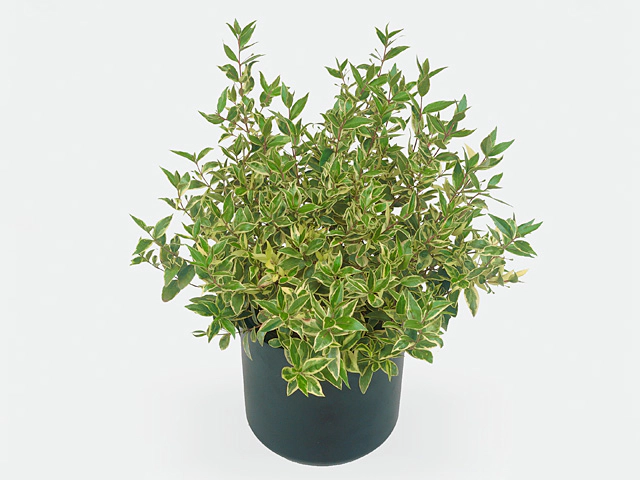Myrtus communis 'Variegata'

| Leaf tip | Acuminate |
| Fruit type | Berry |
| Leaf type | Foliage leaf |
| Winter hardness | Limited (USDA-zone 8) |
| Leaf, general shape | Elongate |
| Leaf, scent | Pleasantly scented |
| Structure (tissues) | Woody |
| Leaf width | 1 - 2 cm |
| Leaf size | 2 - 3 cm |
| Light conditions | Sunny |
| Leaf division | Simple |
| Plant, growth type | Erect |
| Leaf, main color | Dark green |
| Leaf colour, pattern | Feathered; Marginate |
| Leaf, secondary color(s) | Yellow |
| Toxicity (if consumed) | Not or barely |
| Moisture requirements | Well-drained |
Myrtus communis 'Variegata', commonly known as variegated myrtle, is a beautiful evergreen shrub that adds a touch of elegance to any garden. With its elongate, dark green foliage that is marginate and feathered in yellow, this plant is a true standout.
One of the striking features of the variegated myrtle is its pleasant scent. The leaves emit a delightful fragrance that adds an aromatic element to the garden. The foliage is simple in division, with an acuminate leaf tip and a width of 1-2 cm and size of 2-3 cm. The plant grows erect, reaching a moderate height with a woody structure.
While the variegated myrtle enjoys sunny light conditions, it is important to provide it with well-drained soil. This plant prefers a moisture level that is not waterlogged, ensuring that the roots remain healthy. Although it can tolerate some winter cold, it has limited winter hardiness and is best suited for USDA zone 8.
One of the advantages of this plant is its berry fruit type. The myrtle produces small berries that add visual interest to the shrub. However, it is important to note that the plant's toxicity is very low, making it safe for consumption in small amounts.
The variegated myrtle is a versatile plant that can be used in various ways in the garden. It can be grown as a hedge, a specimen plant, or even in containers. Its graceful foliage adds texture and color to any landscape, making it a popular choice among gardeners.
To care for the variegated myrtle, regular pruning can be done to maintain its shape and size. This will also help promote healthy growth and maintain the desired look. Fertilizing the plant once a year with a balanced fertilizer will ensure it receives the necessary nutrients to thrive.
In conclusion, Myrtus communis 'Variegata' is a stunning addition to any garden. With its uniquely patterned foliage, pleasant scent, and versatile uses, it is a plant that deserves a place in your landscape. Just ensure it is provided with well-drained soil, adequate sunlight, and some winter protection, and you will be rewarded with a beautiful and fragrant shrub that will bring joy for years to come.
Market availability index by month:
| Jan. | Feb. | Mar. | Apr. | May | Jun. | Jul. | Aug. | Sep. | Oct. | Nov. | Dec. |
|---|---|---|---|---|---|---|---|---|---|---|---|
| - | - | 4 | - | - | - | - | - | 3 | - | - | - |